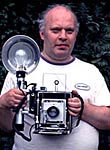|
|
This topic comprises 2 pages: 1 2
|
|
Author
|
Topic: Stuck pixel during DLP presentation
|
|
|
|
|
|
|
|
|
|
|
|
|
|
|
|
|
|
|
|
|
|
|
Frank Angel
Film God

Posts: 5305
From: Brooklyn NY USA
Registered: Dec 1999
|
 posted 07-17-2008 01:35 PM
posted 07-17-2008 01:35 PM





Most scratches and dirt are intermittent. Stuck pixels are steady-state and MUCH more annoying. Scratches and dirt come from poor handling of the film, not from the projector. You can change a damaged print; it's a lot more costly to replace that DLP nano mirror module. And this is only a few years out. At least with a 35mm film projector, you don't expect to find its weaknesses showing up this early on.
Look, there is NO technology that is perfect. There are going to be weaknesses. With digital, the maintenance costs to keep ahead of them showing up is much more costly than with a film based system. Stuck or dead pixels are inherent in the video display technology, so someplace along the line those specks of light or black are going to start to populate digital projector displays, the question is how soon and how costly will it be to repair them.
Second question is, those same theatre operators who wouldn't foot the cost to buy a supply of Film Guard and a Kelmar cleaner to prevent dirt and scratches or who let bulbs burn to the point were the picture is barely visible, they're THE SAME GUYS running the digital booths. How reluctant will these owners be to replace a very expensive malfunctoning nano-mirror module? Only time will tell, but I wouldn't put any bets on theatre owners stepping up to the plate when digital equipment starts to show its age. The big problem is that it may very well start showing its age long before a 35mm projector shows it's flaws.
The digevangelists were always comparing how images looked when the DLPs were newly tweaked and practically out of the box against old 35mm equipment that had been running in theatres for decades. It wasn't a fair comparison. Sure, you can plop a new $100,000 digital projector system in a theatre that's been run poorly and it will fix a multitude of sins -- for the moment, but it is still in a theatre that is RUN POORLY. The equipment won't change that. Sooner or later the neglect that made 35mm look bad there will impact the digital there as well. And since digital will cost ALLOT more to repair, it is foolish to think these operators will give any more of a rats ass about presentation than they did with their 35mm systems -- extended warantees not withstanding.
BTW, extended warantees don't make it any less expensive to repair or replace these modules -- it only shifts the cost, and whoever is absorbing that cost is going to pass it back onto the end user one way or another. The cost of having a technician come in to replace failing DMDs is much more than a tech coming in to repair an mechanical intermittent.
| IP: Logged
|
|
|
|
|
|
|
|
|
|
All times are Central (GMT -6:00)
|
This topic comprises 2 pages: 1 2
|
Powered by Infopop Corporation
UBB.classicTM
6.3.1.2
The Film-Tech Forums are designed for various members related to the cinema industry to express their opinions, viewpoints and testimonials on various products, services and events based upon speculation, personal knowledge and factual information through use, therefore all views represented here allow no liability upon the publishers of this web site and the owners of said views assume no liability for any ill will resulting from these postings. The posts made here are for educational as well as entertainment purposes and as such anyone viewing this portion of the website must accept these views as statements of the author of that opinion
and agrees to release the authors from any and all liability.
|

 Home
Home
 Products
Products
 Store
Store
 Forum
Forum
 Warehouse
Warehouse
 Contact Us
Contact Us




 Printer-friendly view of this topic
Printer-friendly view of this topic














